Commercial Property Management: GFC Impact and Future in Australia
VerifiedAdded on 2023/04/21
|28
|7311
|282
Report
AI Summary
This report examines the current and future implications for commercial property managers in Australia, particularly in light of structural changes in the Australian economy. It begins with an executive summary that emphasizes the importance of understanding property cycles and the impact of economic downturns, using the Global Financial Crisis (GFC) of 2007-2009 as a key case study. The report delves into the causes of the GFC, including the role of sub-prime loans in the United States and their ripple effects globally. It analyzes the impact of the GFC on the Australian property sector, including declining market rents, rising vacancy rates, and increased outgoings, using the case study of '18 Smith Street, Parramatta NSW' as a small insight into office property. The report provides a historical overview of the GFC, detailing the deregulation of the financial system, the rise of affordable credit, and the subsequent issues that led to the crisis. It also assesses the impacts on Australian banks and the government's response to the crisis. Furthermore, the report includes a literature review and a discussion section that focuses on Sydney office property, discussing vacancy rates, market rents, outgoings, and future forecasts, as well as preventative strategies for commercial property managers. The analysis also touches on key economic indicators prior to the GFC, the impact on housing prices, and the role of banks and borrowers in the crisis. The report concludes with a summary of findings and a list of references.
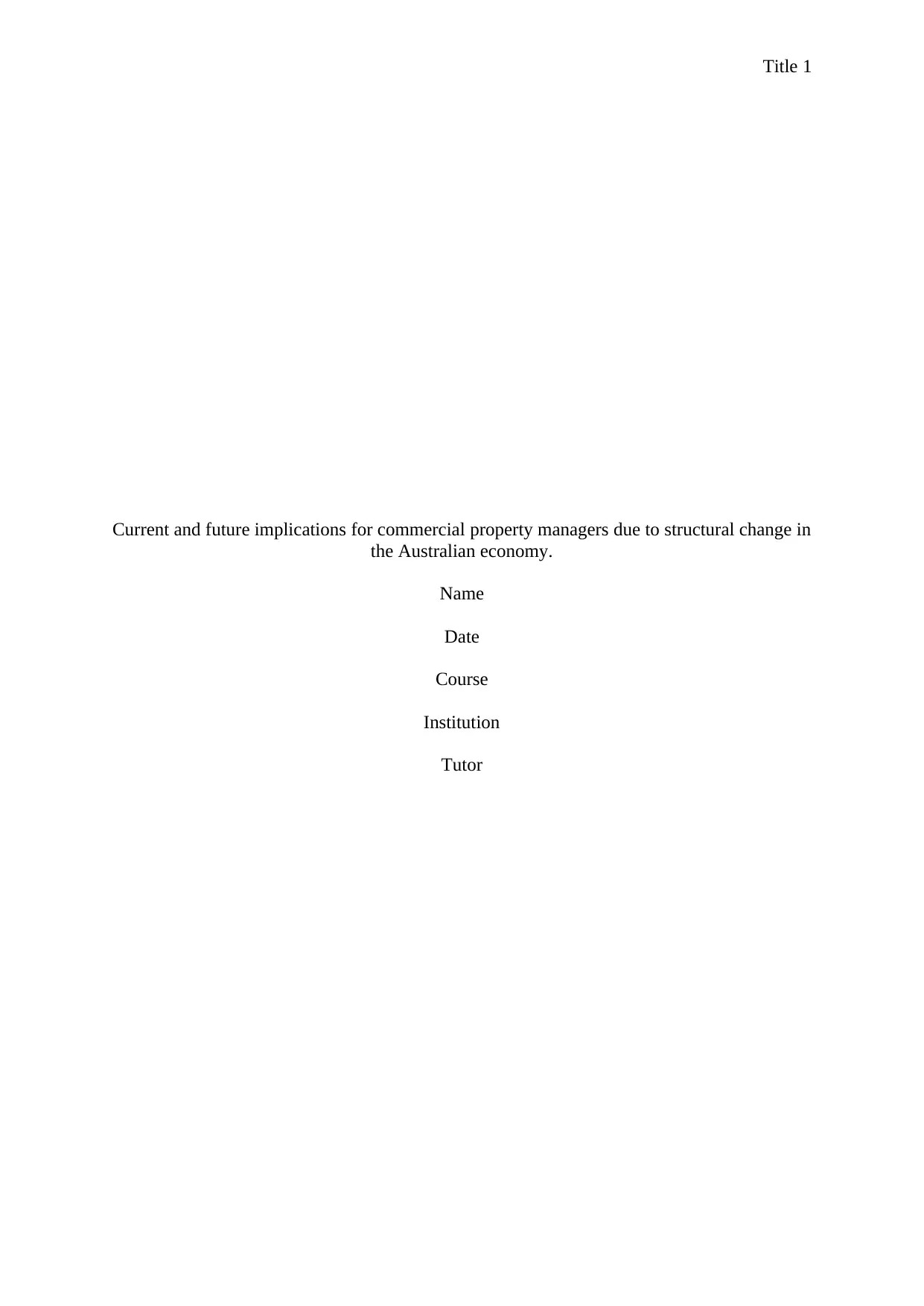
Title 1
Current and future implications for commercial property managers due to structural change in
the Australian economy.
Name
Date
Course
Institution
Tutor
Current and future implications for commercial property managers due to structural change in
the Australian economy.
Name
Date
Course
Institution
Tutor
Paraphrase This Document
Need a fresh take? Get an instant paraphrase of this document with our AI Paraphraser
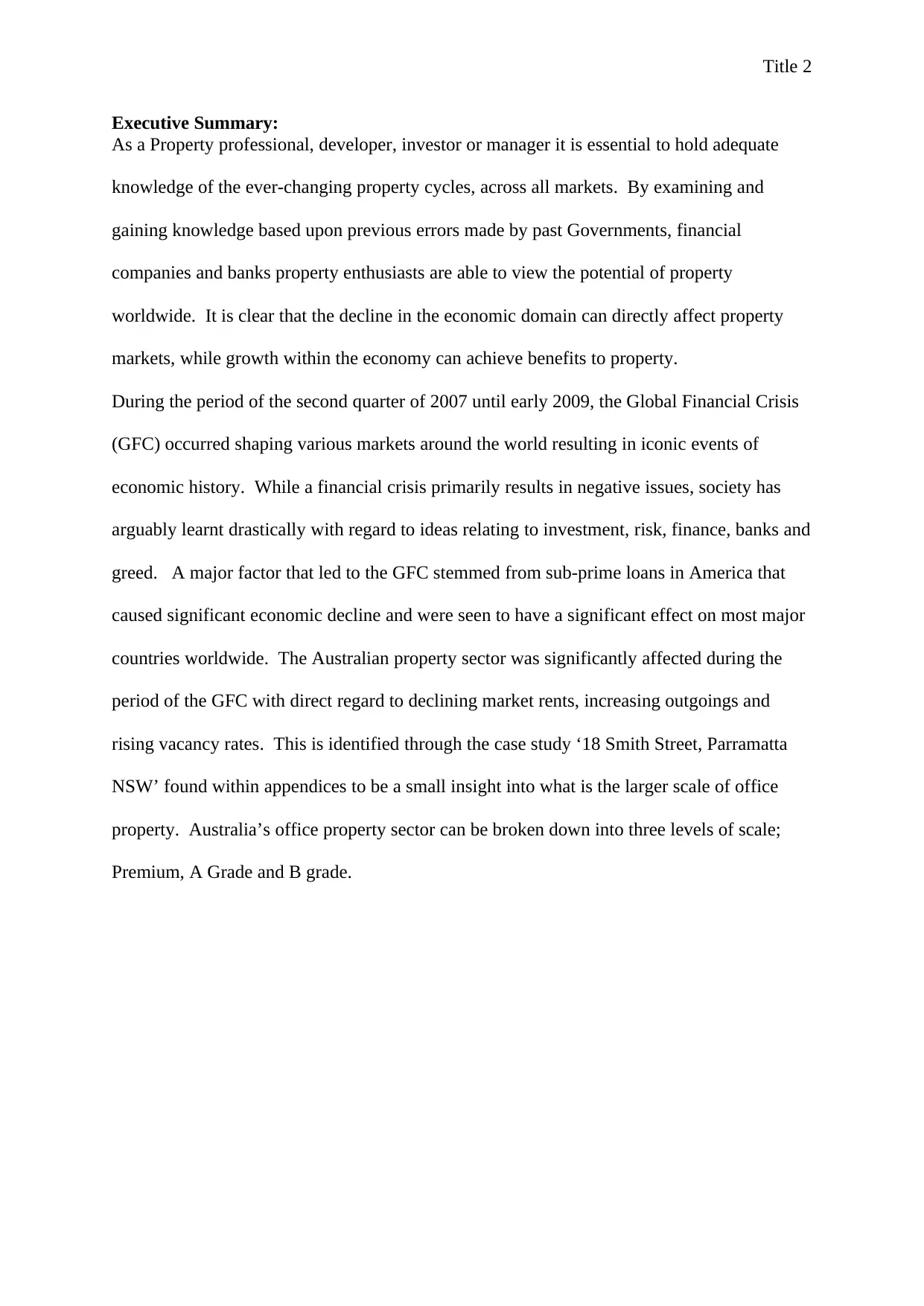
Title 2
Executive Summary:
As a Property professional, developer, investor or manager it is essential to hold adequate
knowledge of the ever-changing property cycles, across all markets. By examining and
gaining knowledge based upon previous errors made by past Governments, financial
companies and banks property enthusiasts are able to view the potential of property
worldwide. It is clear that the decline in the economic domain can directly affect property
markets, while growth within the economy can achieve benefits to property.
During the period of the second quarter of 2007 until early 2009, the Global Financial Crisis
(GFC) occurred shaping various markets around the world resulting in iconic events of
economic history. While a financial crisis primarily results in negative issues, society has
arguably learnt drastically with regard to ideas relating to investment, risk, finance, banks and
greed. A major factor that led to the GFC stemmed from sub-prime loans in America that
caused significant economic decline and were seen to have a significant effect on most major
countries worldwide. The Australian property sector was significantly affected during the
period of the GFC with direct regard to declining market rents, increasing outgoings and
rising vacancy rates. This is identified through the case study ‘18 Smith Street, Parramatta
NSW’ found within appendices to be a small insight into what is the larger scale of office
property. Australia’s office property sector can be broken down into three levels of scale;
Premium, A Grade and B grade.
Executive Summary:
As a Property professional, developer, investor or manager it is essential to hold adequate
knowledge of the ever-changing property cycles, across all markets. By examining and
gaining knowledge based upon previous errors made by past Governments, financial
companies and banks property enthusiasts are able to view the potential of property
worldwide. It is clear that the decline in the economic domain can directly affect property
markets, while growth within the economy can achieve benefits to property.
During the period of the second quarter of 2007 until early 2009, the Global Financial Crisis
(GFC) occurred shaping various markets around the world resulting in iconic events of
economic history. While a financial crisis primarily results in negative issues, society has
arguably learnt drastically with regard to ideas relating to investment, risk, finance, banks and
greed. A major factor that led to the GFC stemmed from sub-prime loans in America that
caused significant economic decline and were seen to have a significant effect on most major
countries worldwide. The Australian property sector was significantly affected during the
period of the GFC with direct regard to declining market rents, increasing outgoings and
rising vacancy rates. This is identified through the case study ‘18 Smith Street, Parramatta
NSW’ found within appendices to be a small insight into what is the larger scale of office
property. Australia’s office property sector can be broken down into three levels of scale;
Premium, A Grade and B grade.
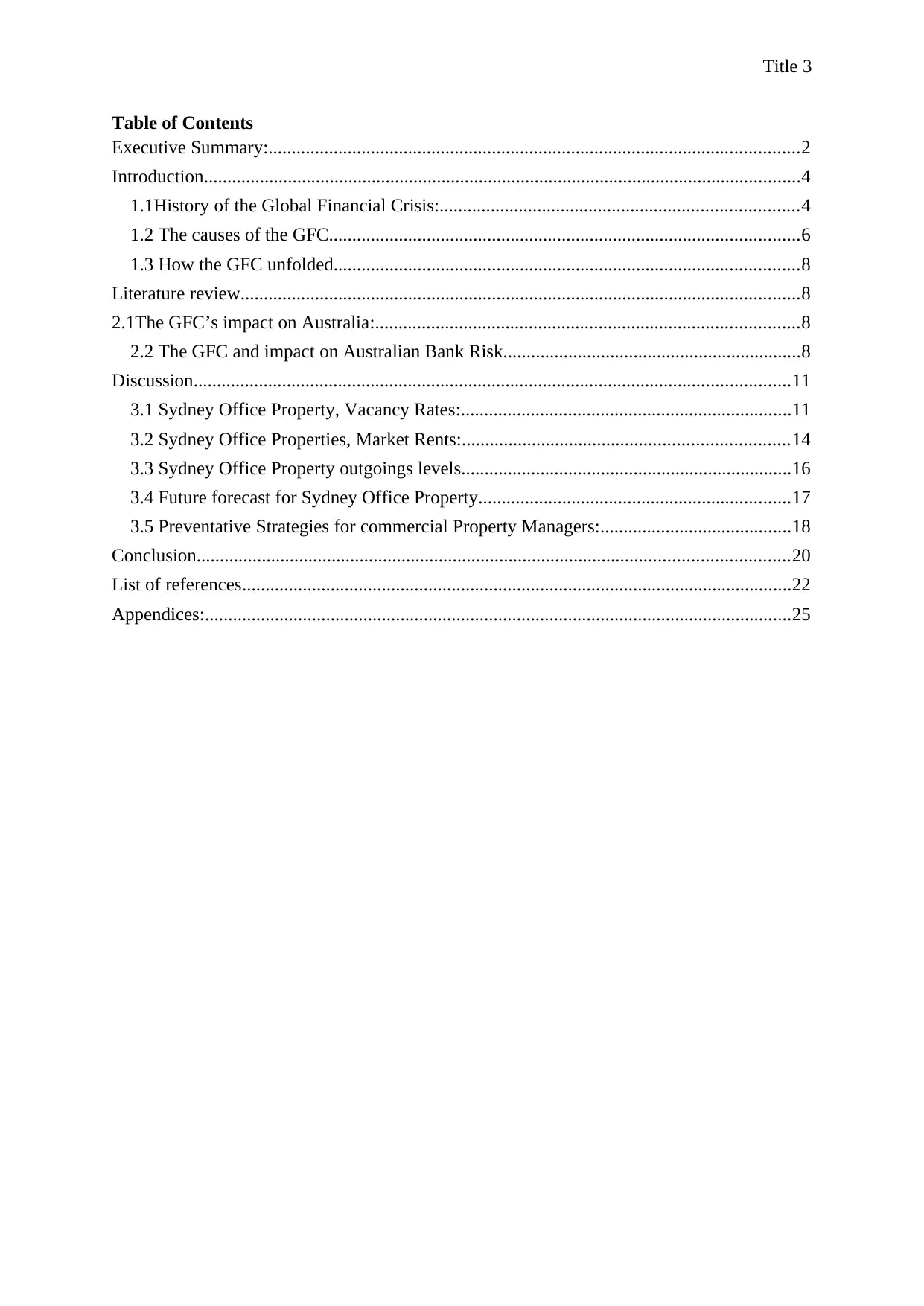
Title 3
Table of Contents
Executive Summary:..................................................................................................................2
Introduction................................................................................................................................4
1.1History of the Global Financial Crisis:.............................................................................4
1.2 The causes of the GFC.....................................................................................................6
1.3 How the GFC unfolded....................................................................................................8
Literature review........................................................................................................................8
2.1The GFC’s impact on Australia:...........................................................................................8
2.2 The GFC and impact on Australian Bank Risk................................................................8
Discussion................................................................................................................................11
3.1 Sydney Office Property, Vacancy Rates:.......................................................................11
3.2 Sydney Office Properties, Market Rents:......................................................................14
3.3 Sydney Office Property outgoings levels.......................................................................16
3.4 Future forecast for Sydney Office Property...................................................................17
3.5 Preventative Strategies for commercial Property Managers:.........................................18
Conclusion...............................................................................................................................20
List of references......................................................................................................................22
Appendices:..............................................................................................................................25
Table of Contents
Executive Summary:..................................................................................................................2
Introduction................................................................................................................................4
1.1History of the Global Financial Crisis:.............................................................................4
1.2 The causes of the GFC.....................................................................................................6
1.3 How the GFC unfolded....................................................................................................8
Literature review........................................................................................................................8
2.1The GFC’s impact on Australia:...........................................................................................8
2.2 The GFC and impact on Australian Bank Risk................................................................8
Discussion................................................................................................................................11
3.1 Sydney Office Property, Vacancy Rates:.......................................................................11
3.2 Sydney Office Properties, Market Rents:......................................................................14
3.3 Sydney Office Property outgoings levels.......................................................................16
3.4 Future forecast for Sydney Office Property...................................................................17
3.5 Preventative Strategies for commercial Property Managers:.........................................18
Conclusion...............................................................................................................................20
List of references......................................................................................................................22
Appendices:..............................................................................................................................25
⊘ This is a preview!⊘
Do you want full access?
Subscribe today to unlock all pages.

Trusted by 1+ million students worldwide
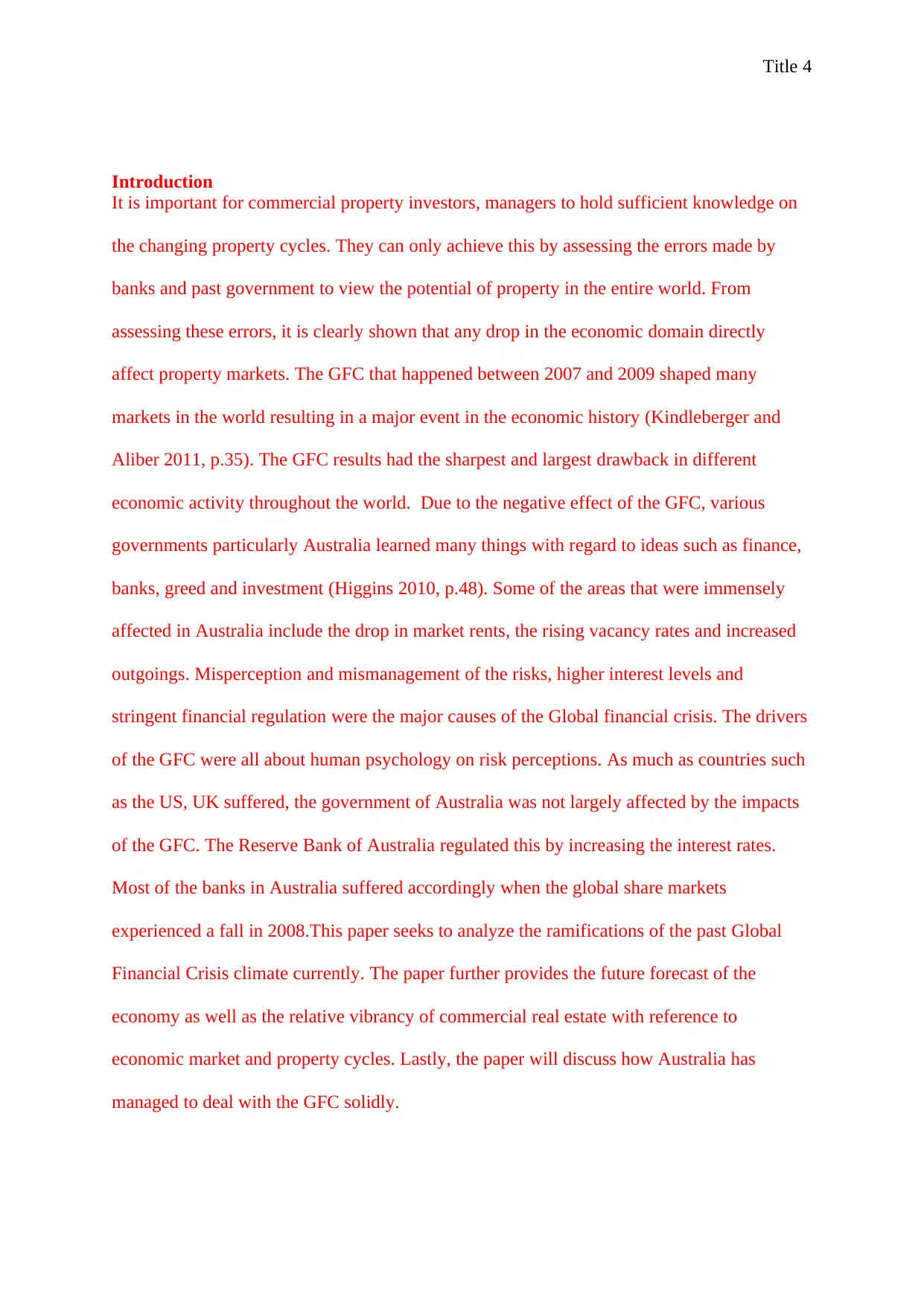
Title 4
Introduction
It is important for commercial property investors, managers to hold sufficient knowledge on
the changing property cycles. They can only achieve this by assessing the errors made by
banks and past government to view the potential of property in the entire world. From
assessing these errors, it is clearly shown that any drop in the economic domain directly
affect property markets. The GFC that happened between 2007 and 2009 shaped many
markets in the world resulting in a major event in the economic history (Kindleberger and
Aliber 2011, p.35). The GFC results had the sharpest and largest drawback in different
economic activity throughout the world. Due to the negative effect of the GFC, various
governments particularly Australia learned many things with regard to ideas such as finance,
banks, greed and investment (Higgins 2010, p.48). Some of the areas that were immensely
affected in Australia include the drop in market rents, the rising vacancy rates and increased
outgoings. Misperception and mismanagement of the risks, higher interest levels and
stringent financial regulation were the major causes of the Global financial crisis. The drivers
of the GFC were all about human psychology on risk perceptions. As much as countries such
as the US, UK suffered, the government of Australia was not largely affected by the impacts
of the GFC. The Reserve Bank of Australia regulated this by increasing the interest rates.
Most of the banks in Australia suffered accordingly when the global share markets
experienced a fall in 2008.This paper seeks to analyze the ramifications of the past Global
Financial Crisis climate currently. The paper further provides the future forecast of the
economy as well as the relative vibrancy of commercial real estate with reference to
economic market and property cycles. Lastly, the paper will discuss how Australia has
managed to deal with the GFC solidly.
Introduction
It is important for commercial property investors, managers to hold sufficient knowledge on
the changing property cycles. They can only achieve this by assessing the errors made by
banks and past government to view the potential of property in the entire world. From
assessing these errors, it is clearly shown that any drop in the economic domain directly
affect property markets. The GFC that happened between 2007 and 2009 shaped many
markets in the world resulting in a major event in the economic history (Kindleberger and
Aliber 2011, p.35). The GFC results had the sharpest and largest drawback in different
economic activity throughout the world. Due to the negative effect of the GFC, various
governments particularly Australia learned many things with regard to ideas such as finance,
banks, greed and investment (Higgins 2010, p.48). Some of the areas that were immensely
affected in Australia include the drop in market rents, the rising vacancy rates and increased
outgoings. Misperception and mismanagement of the risks, higher interest levels and
stringent financial regulation were the major causes of the Global financial crisis. The drivers
of the GFC were all about human psychology on risk perceptions. As much as countries such
as the US, UK suffered, the government of Australia was not largely affected by the impacts
of the GFC. The Reserve Bank of Australia regulated this by increasing the interest rates.
Most of the banks in Australia suffered accordingly when the global share markets
experienced a fall in 2008.This paper seeks to analyze the ramifications of the past Global
Financial Crisis climate currently. The paper further provides the future forecast of the
economy as well as the relative vibrancy of commercial real estate with reference to
economic market and property cycles. Lastly, the paper will discuss how Australia has
managed to deal with the GFC solidly.
Paraphrase This Document
Need a fresh take? Get an instant paraphrase of this document with our AI Paraphraser
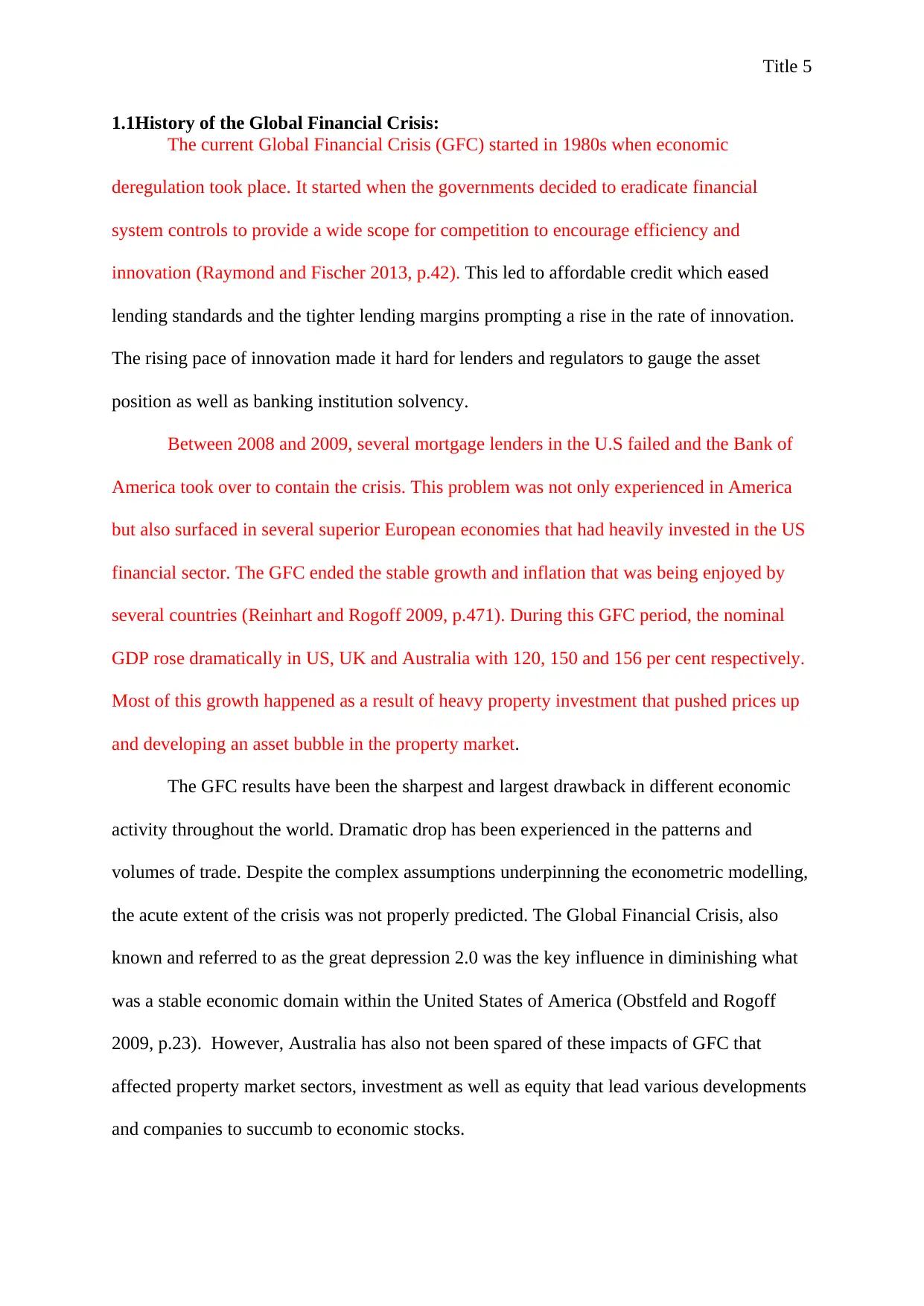
Title 5
1.1History of the Global Financial Crisis:
The current Global Financial Crisis (GFC) started in 1980s when economic
deregulation took place. It started when the governments decided to eradicate financial
system controls to provide a wide scope for competition to encourage efficiency and
innovation (Raymond and Fischer 2013, p.42). This led to affordable credit which eased
lending standards and the tighter lending margins prompting a rise in the rate of innovation.
The rising pace of innovation made it hard for lenders and regulators to gauge the asset
position as well as banking institution solvency.
Between 2008 and 2009, several mortgage lenders in the U.S failed and the Bank of
America took over to contain the crisis. This problem was not only experienced in America
but also surfaced in several superior European economies that had heavily invested in the US
financial sector. The GFC ended the stable growth and inflation that was being enjoyed by
several countries (Reinhart and Rogoff 2009, p.471). During this GFC period, the nominal
GDP rose dramatically in US, UK and Australia with 120, 150 and 156 per cent respectively.
Most of this growth happened as a result of heavy property investment that pushed prices up
and developing an asset bubble in the property market.
The GFC results have been the sharpest and largest drawback in different economic
activity throughout the world. Dramatic drop has been experienced in the patterns and
volumes of trade. Despite the complex assumptions underpinning the econometric modelling,
the acute extent of the crisis was not properly predicted. The Global Financial Crisis, also
known and referred to as the great depression 2.0 was the key influence in diminishing what
was a stable economic domain within the United States of America (Obstfeld and Rogoff
2009, p.23). However, Australia has also not been spared of these impacts of GFC that
affected property market sectors, investment as well as equity that lead various developments
and companies to succumb to economic stocks.
1.1History of the Global Financial Crisis:
The current Global Financial Crisis (GFC) started in 1980s when economic
deregulation took place. It started when the governments decided to eradicate financial
system controls to provide a wide scope for competition to encourage efficiency and
innovation (Raymond and Fischer 2013, p.42). This led to affordable credit which eased
lending standards and the tighter lending margins prompting a rise in the rate of innovation.
The rising pace of innovation made it hard for lenders and regulators to gauge the asset
position as well as banking institution solvency.
Between 2008 and 2009, several mortgage lenders in the U.S failed and the Bank of
America took over to contain the crisis. This problem was not only experienced in America
but also surfaced in several superior European economies that had heavily invested in the US
financial sector. The GFC ended the stable growth and inflation that was being enjoyed by
several countries (Reinhart and Rogoff 2009, p.471). During this GFC period, the nominal
GDP rose dramatically in US, UK and Australia with 120, 150 and 156 per cent respectively.
Most of this growth happened as a result of heavy property investment that pushed prices up
and developing an asset bubble in the property market.
The GFC results have been the sharpest and largest drawback in different economic
activity throughout the world. Dramatic drop has been experienced in the patterns and
volumes of trade. Despite the complex assumptions underpinning the econometric modelling,
the acute extent of the crisis was not properly predicted. The Global Financial Crisis, also
known and referred to as the great depression 2.0 was the key influence in diminishing what
was a stable economic domain within the United States of America (Obstfeld and Rogoff
2009, p.23). However, Australia has also not been spared of these impacts of GFC that
affected property market sectors, investment as well as equity that lead various developments
and companies to succumb to economic stocks.
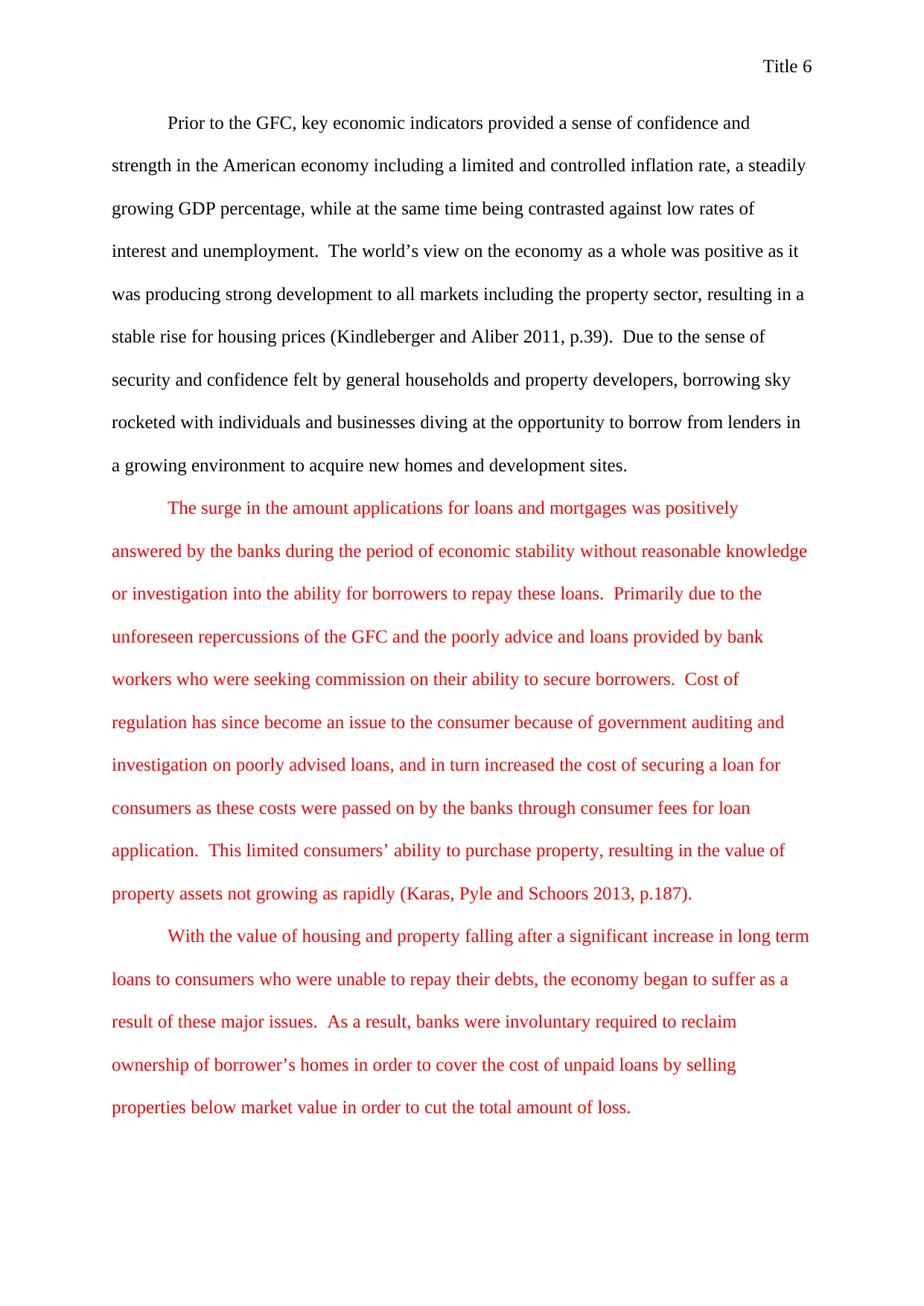
Title 6
Prior to the GFC, key economic indicators provided a sense of confidence and
strength in the American economy including a limited and controlled inflation rate, a steadily
growing GDP percentage, while at the same time being contrasted against low rates of
interest and unemployment. The world’s view on the economy as a whole was positive as it
was producing strong development to all markets including the property sector, resulting in a
stable rise for housing prices (Kindleberger and Aliber 2011, p.39). Due to the sense of
security and confidence felt by general households and property developers, borrowing sky
rocketed with individuals and businesses diving at the opportunity to borrow from lenders in
a growing environment to acquire new homes and development sites.
The surge in the amount applications for loans and mortgages was positively
answered by the banks during the period of economic stability without reasonable knowledge
or investigation into the ability for borrowers to repay these loans. Primarily due to the
unforeseen repercussions of the GFC and the poorly advice and loans provided by bank
workers who were seeking commission on their ability to secure borrowers. Cost of
regulation has since become an issue to the consumer because of government auditing and
investigation on poorly advised loans, and in turn increased the cost of securing a loan for
consumers as these costs were passed on by the banks through consumer fees for loan
application. This limited consumers’ ability to purchase property, resulting in the value of
property assets not growing as rapidly (Karas, Pyle and Schoors 2013, p.187).
With the value of housing and property falling after a significant increase in long term
loans to consumers who were unable to repay their debts, the economy began to suffer as a
result of these major issues. As a result, banks were involuntary required to reclaim
ownership of borrower’s homes in order to cover the cost of unpaid loans by selling
properties below market value in order to cut the total amount of loss.
Prior to the GFC, key economic indicators provided a sense of confidence and
strength in the American economy including a limited and controlled inflation rate, a steadily
growing GDP percentage, while at the same time being contrasted against low rates of
interest and unemployment. The world’s view on the economy as a whole was positive as it
was producing strong development to all markets including the property sector, resulting in a
stable rise for housing prices (Kindleberger and Aliber 2011, p.39). Due to the sense of
security and confidence felt by general households and property developers, borrowing sky
rocketed with individuals and businesses diving at the opportunity to borrow from lenders in
a growing environment to acquire new homes and development sites.
The surge in the amount applications for loans and mortgages was positively
answered by the banks during the period of economic stability without reasonable knowledge
or investigation into the ability for borrowers to repay these loans. Primarily due to the
unforeseen repercussions of the GFC and the poorly advice and loans provided by bank
workers who were seeking commission on their ability to secure borrowers. Cost of
regulation has since become an issue to the consumer because of government auditing and
investigation on poorly advised loans, and in turn increased the cost of securing a loan for
consumers as these costs were passed on by the banks through consumer fees for loan
application. This limited consumers’ ability to purchase property, resulting in the value of
property assets not growing as rapidly (Karas, Pyle and Schoors 2013, p.187).
With the value of housing and property falling after a significant increase in long term
loans to consumers who were unable to repay their debts, the economy began to suffer as a
result of these major issues. As a result, banks were involuntary required to reclaim
ownership of borrower’s homes in order to cover the cost of unpaid loans by selling
properties below market value in order to cut the total amount of loss.
⊘ This is a preview!⊘
Do you want full access?
Subscribe today to unlock all pages.

Trusted by 1+ million students worldwide
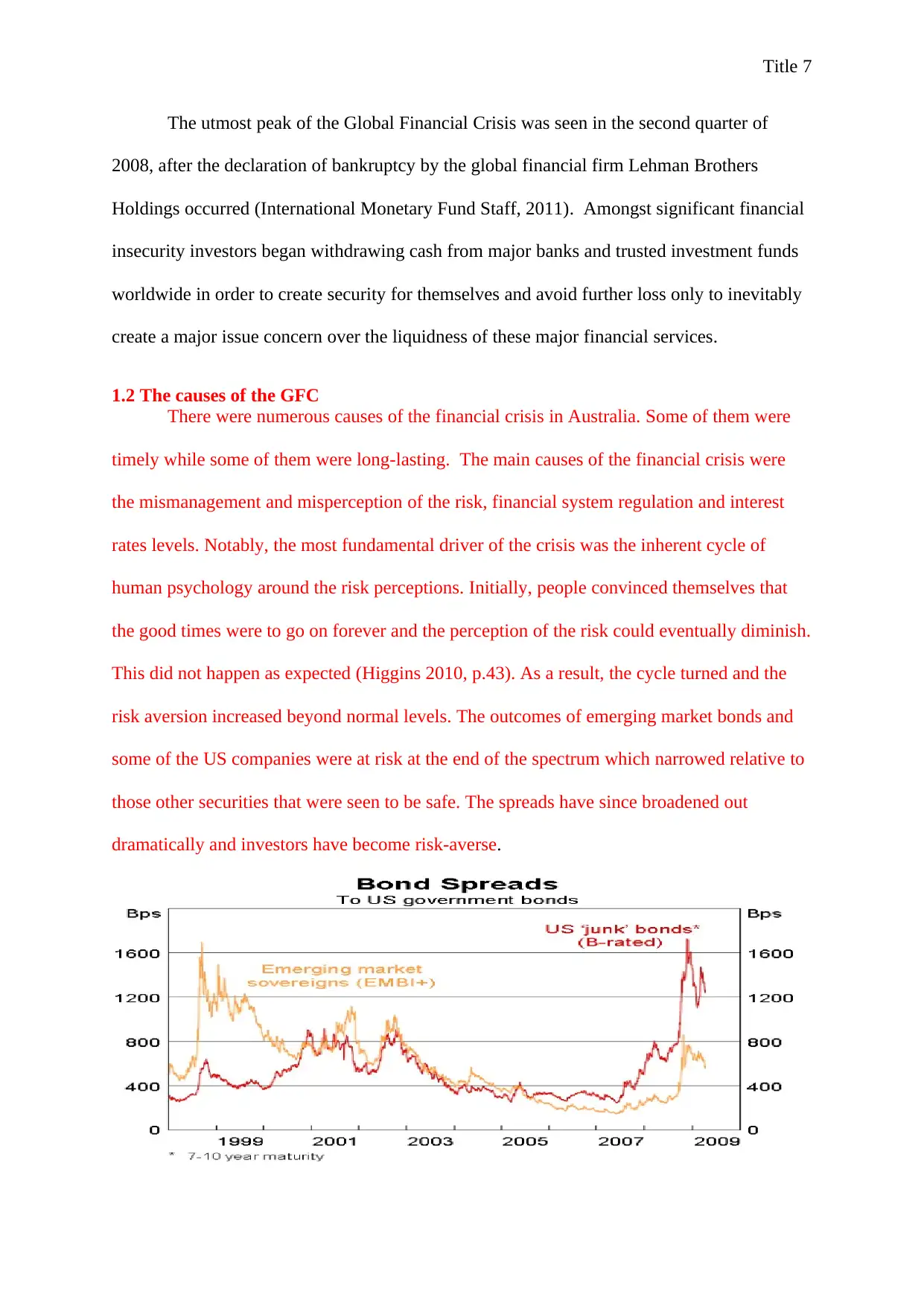
Title 7
The utmost peak of the Global Financial Crisis was seen in the second quarter of
2008, after the declaration of bankruptcy by the global financial firm Lehman Brothers
Holdings occurred (International Monetary Fund Staff, 2011). Amongst significant financial
insecurity investors began withdrawing cash from major banks and trusted investment funds
worldwide in order to create security for themselves and avoid further loss only to inevitably
create a major issue concern over the liquidness of these major financial services.
1.2 The causes of the GFC
There were numerous causes of the financial crisis in Australia. Some of them were
timely while some of them were long-lasting. The main causes of the financial crisis were
the mismanagement and misperception of the risk, financial system regulation and interest
rates levels. Notably, the most fundamental driver of the crisis was the inherent cycle of
human psychology around the risk perceptions. Initially, people convinced themselves that
the good times were to go on forever and the perception of the risk could eventually diminish.
This did not happen as expected (Higgins 2010, p.43). As a result, the cycle turned and the
risk aversion increased beyond normal levels. The outcomes of emerging market bonds and
some of the US companies were at risk at the end of the spectrum which narrowed relative to
those other securities that were seen to be safe. The spreads have since broadened out
dramatically and investors have become risk-averse.
The utmost peak of the Global Financial Crisis was seen in the second quarter of
2008, after the declaration of bankruptcy by the global financial firm Lehman Brothers
Holdings occurred (International Monetary Fund Staff, 2011). Amongst significant financial
insecurity investors began withdrawing cash from major banks and trusted investment funds
worldwide in order to create security for themselves and avoid further loss only to inevitably
create a major issue concern over the liquidness of these major financial services.
1.2 The causes of the GFC
There were numerous causes of the financial crisis in Australia. Some of them were
timely while some of them were long-lasting. The main causes of the financial crisis were
the mismanagement and misperception of the risk, financial system regulation and interest
rates levels. Notably, the most fundamental driver of the crisis was the inherent cycle of
human psychology around the risk perceptions. Initially, people convinced themselves that
the good times were to go on forever and the perception of the risk could eventually diminish.
This did not happen as expected (Higgins 2010, p.43). As a result, the cycle turned and the
risk aversion increased beyond normal levels. The outcomes of emerging market bonds and
some of the US companies were at risk at the end of the spectrum which narrowed relative to
those other securities that were seen to be safe. The spreads have since broadened out
dramatically and investors have become risk-averse.
Paraphrase This Document
Need a fresh take? Get an instant paraphrase of this document with our AI Paraphraser
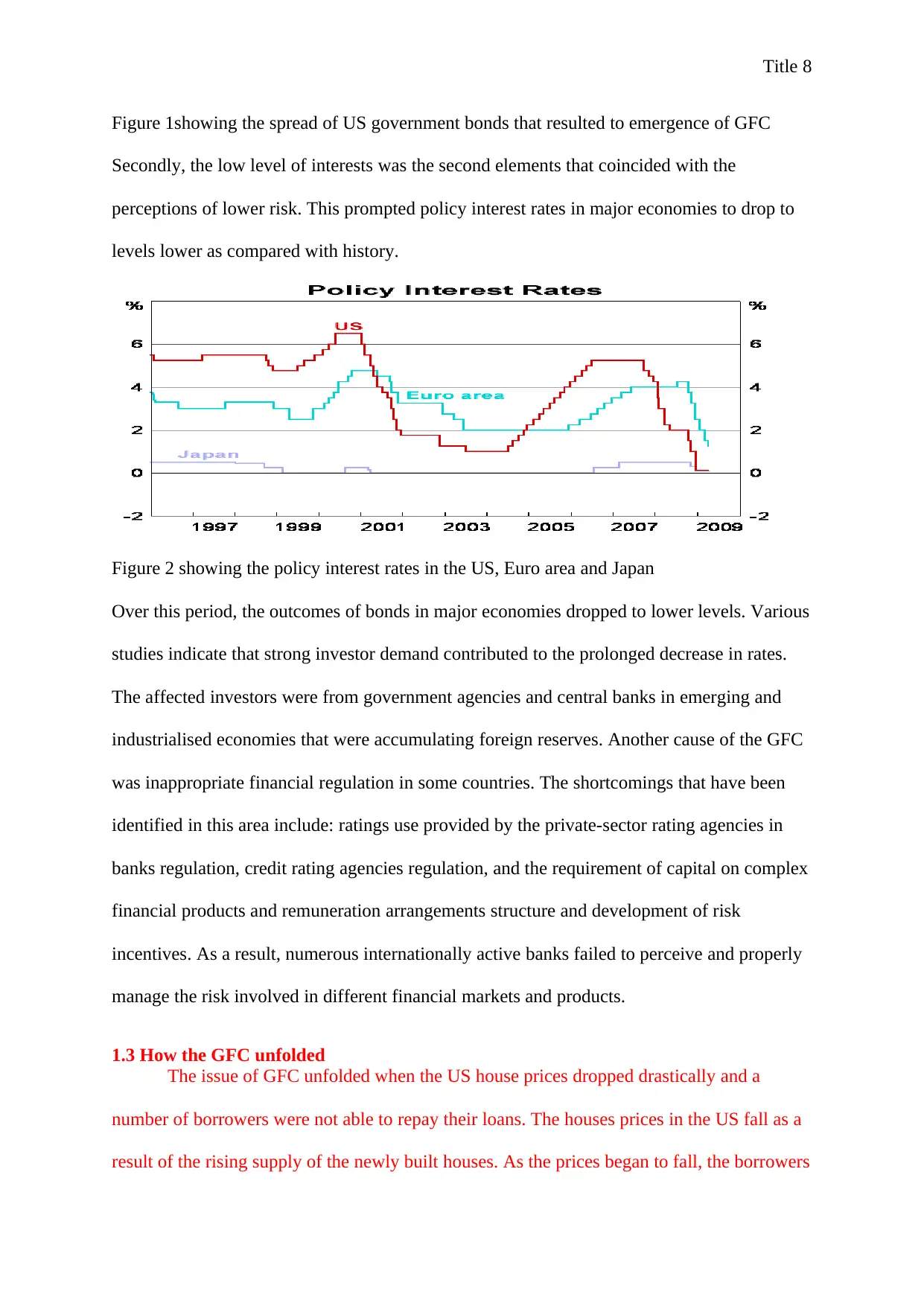
Title 8
Figure 1showing the spread of US government bonds that resulted to emergence of GFC
Secondly, the low level of interests was the second elements that coincided with the
perceptions of lower risk. This prompted policy interest rates in major economies to drop to
levels lower as compared with history.
Figure 2 showing the policy interest rates in the US, Euro area and Japan
Over this period, the outcomes of bonds in major economies dropped to lower levels. Various
studies indicate that strong investor demand contributed to the prolonged decrease in rates.
The affected investors were from government agencies and central banks in emerging and
industrialised economies that were accumulating foreign reserves. Another cause of the GFC
was inappropriate financial regulation in some countries. The shortcomings that have been
identified in this area include: ratings use provided by the private-sector rating agencies in
banks regulation, credit rating agencies regulation, and the requirement of capital on complex
financial products and remuneration arrangements structure and development of risk
incentives. As a result, numerous internationally active banks failed to perceive and properly
manage the risk involved in different financial markets and products.
1.3 How the GFC unfolded
The issue of GFC unfolded when the US house prices dropped drastically and a
number of borrowers were not able to repay their loans. The houses prices in the US fall as a
result of the rising supply of the newly built houses. As the prices began to fall, the borrowers
Figure 1showing the spread of US government bonds that resulted to emergence of GFC
Secondly, the low level of interests was the second elements that coincided with the
perceptions of lower risk. This prompted policy interest rates in major economies to drop to
levels lower as compared with history.
Figure 2 showing the policy interest rates in the US, Euro area and Japan
Over this period, the outcomes of bonds in major economies dropped to lower levels. Various
studies indicate that strong investor demand contributed to the prolonged decrease in rates.
The affected investors were from government agencies and central banks in emerging and
industrialised economies that were accumulating foreign reserves. Another cause of the GFC
was inappropriate financial regulation in some countries. The shortcomings that have been
identified in this area include: ratings use provided by the private-sector rating agencies in
banks regulation, credit rating agencies regulation, and the requirement of capital on complex
financial products and remuneration arrangements structure and development of risk
incentives. As a result, numerous internationally active banks failed to perceive and properly
manage the risk involved in different financial markets and products.
1.3 How the GFC unfolded
The issue of GFC unfolded when the US house prices dropped drastically and a
number of borrowers were not able to repay their loans. The houses prices in the US fall as a
result of the rising supply of the newly built houses. As the prices began to fall, the borrowers
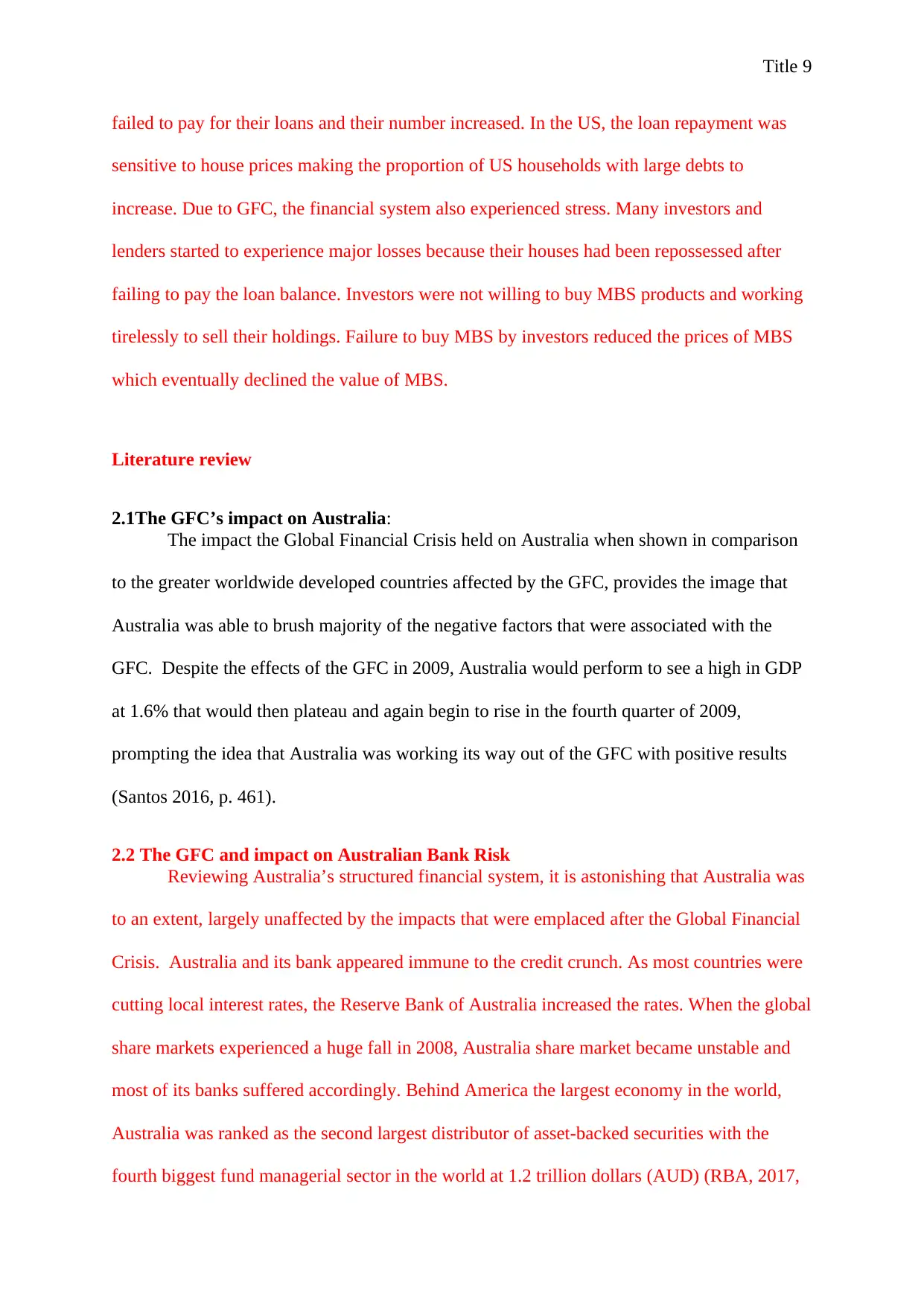
Title 9
failed to pay for their loans and their number increased. In the US, the loan repayment was
sensitive to house prices making the proportion of US households with large debts to
increase. Due to GFC, the financial system also experienced stress. Many investors and
lenders started to experience major losses because their houses had been repossessed after
failing to pay the loan balance. Investors were not willing to buy MBS products and working
tirelessly to sell their holdings. Failure to buy MBS by investors reduced the prices of MBS
which eventually declined the value of MBS.
Literature review
2.1The GFC’s impact on Australia:
The impact the Global Financial Crisis held on Australia when shown in comparison
to the greater worldwide developed countries affected by the GFC, provides the image that
Australia was able to brush majority of the negative factors that were associated with the
GFC. Despite the effects of the GFC in 2009, Australia would perform to see a high in GDP
at 1.6% that would then plateau and again begin to rise in the fourth quarter of 2009,
prompting the idea that Australia was working its way out of the GFC with positive results
(Santos 2016, p. 461).
2.2 The GFC and impact on Australian Bank Risk
Reviewing Australia’s structured financial system, it is astonishing that Australia was
to an extent, largely unaffected by the impacts that were emplaced after the Global Financial
Crisis. Australia and its bank appeared immune to the credit crunch. As most countries were
cutting local interest rates, the Reserve Bank of Australia increased the rates. When the global
share markets experienced a huge fall in 2008, Australia share market became unstable and
most of its banks suffered accordingly. Behind America the largest economy in the world,
Australia was ranked as the second largest distributor of asset-backed securities with the
fourth biggest fund managerial sector in the world at 1.2 trillion dollars (AUD) (RBA, 2017,
failed to pay for their loans and their number increased. In the US, the loan repayment was
sensitive to house prices making the proportion of US households with large debts to
increase. Due to GFC, the financial system also experienced stress. Many investors and
lenders started to experience major losses because their houses had been repossessed after
failing to pay the loan balance. Investors were not willing to buy MBS products and working
tirelessly to sell their holdings. Failure to buy MBS by investors reduced the prices of MBS
which eventually declined the value of MBS.
Literature review
2.1The GFC’s impact on Australia:
The impact the Global Financial Crisis held on Australia when shown in comparison
to the greater worldwide developed countries affected by the GFC, provides the image that
Australia was able to brush majority of the negative factors that were associated with the
GFC. Despite the effects of the GFC in 2009, Australia would perform to see a high in GDP
at 1.6% that would then plateau and again begin to rise in the fourth quarter of 2009,
prompting the idea that Australia was working its way out of the GFC with positive results
(Santos 2016, p. 461).
2.2 The GFC and impact on Australian Bank Risk
Reviewing Australia’s structured financial system, it is astonishing that Australia was
to an extent, largely unaffected by the impacts that were emplaced after the Global Financial
Crisis. Australia and its bank appeared immune to the credit crunch. As most countries were
cutting local interest rates, the Reserve Bank of Australia increased the rates. When the global
share markets experienced a huge fall in 2008, Australia share market became unstable and
most of its banks suffered accordingly. Behind America the largest economy in the world,
Australia was ranked as the second largest distributor of asset-backed securities with the
fourth biggest fund managerial sector in the world at 1.2 trillion dollars (AUD) (RBA, 2017,
⊘ This is a preview!⊘
Do you want full access?
Subscribe today to unlock all pages.

Trusted by 1+ million students worldwide
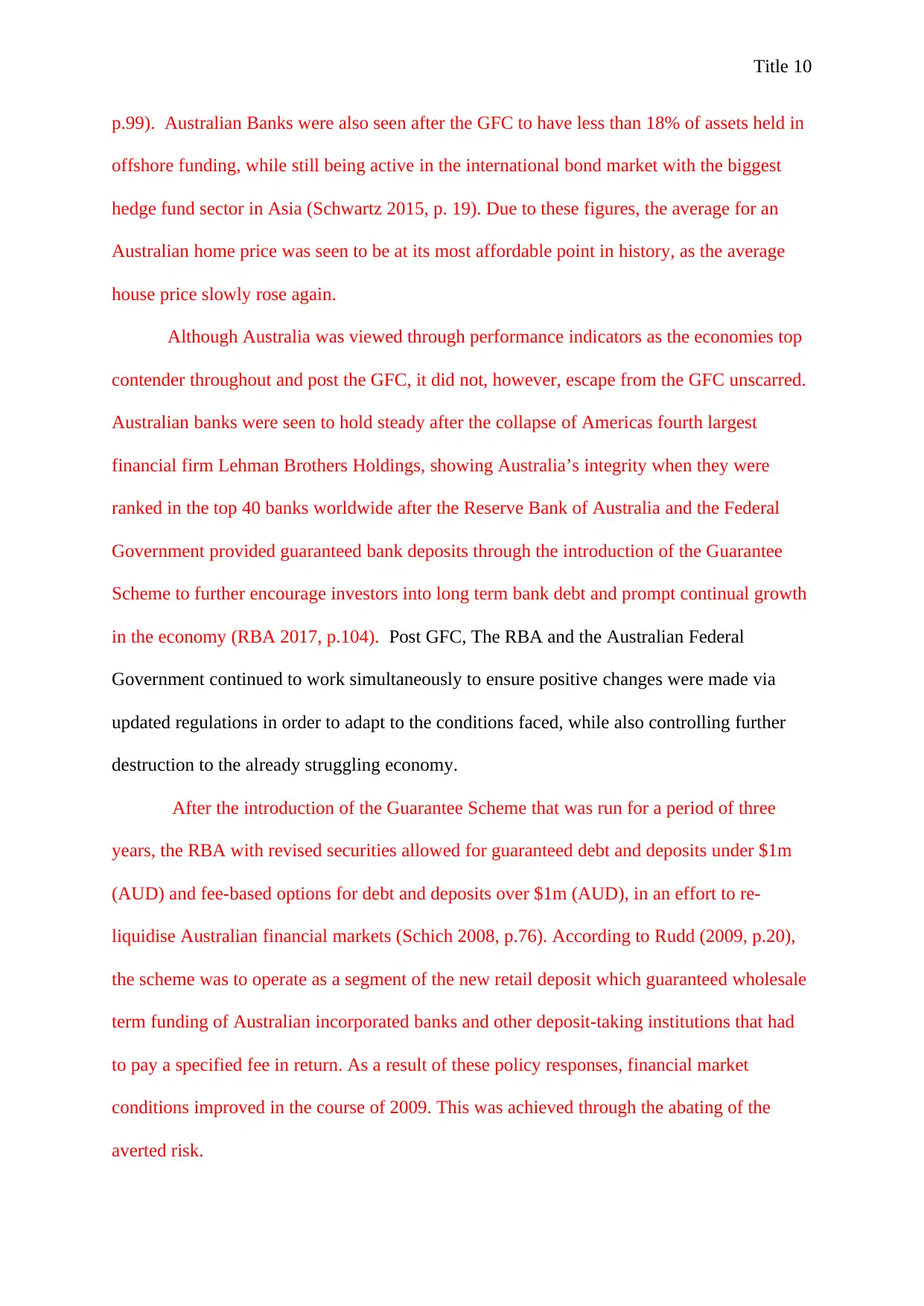
Title 10
p.99). Australian Banks were also seen after the GFC to have less than 18% of assets held in
offshore funding, while still being active in the international bond market with the biggest
hedge fund sector in Asia (Schwartz 2015, p. 19). Due to these figures, the average for an
Australian home price was seen to be at its most affordable point in history, as the average
house price slowly rose again.
Although Australia was viewed through performance indicators as the economies top
contender throughout and post the GFC, it did not, however, escape from the GFC unscarred.
Australian banks were seen to hold steady after the collapse of Americas fourth largest
financial firm Lehman Brothers Holdings, showing Australia’s integrity when they were
ranked in the top 40 banks worldwide after the Reserve Bank of Australia and the Federal
Government provided guaranteed bank deposits through the introduction of the Guarantee
Scheme to further encourage investors into long term bank debt and prompt continual growth
in the economy (RBA 2017, p.104). Post GFC, The RBA and the Australian Federal
Government continued to work simultaneously to ensure positive changes were made via
updated regulations in order to adapt to the conditions faced, while also controlling further
destruction to the already struggling economy.
After the introduction of the Guarantee Scheme that was run for a period of three
years, the RBA with revised securities allowed for guaranteed debt and deposits under $1m
(AUD) and fee-based options for debt and deposits over $1m (AUD), in an effort to re-
liquidise Australian financial markets (Schich 2008, p.76). According to Rudd (2009, p.20),
the scheme was to operate as a segment of the new retail deposit which guaranteed wholesale
term funding of Australian incorporated banks and other deposit-taking institutions that had
to pay a specified fee in return. As a result of these policy responses, financial market
conditions improved in the course of 2009. This was achieved through the abating of the
averted risk.
p.99). Australian Banks were also seen after the GFC to have less than 18% of assets held in
offshore funding, while still being active in the international bond market with the biggest
hedge fund sector in Asia (Schwartz 2015, p. 19). Due to these figures, the average for an
Australian home price was seen to be at its most affordable point in history, as the average
house price slowly rose again.
Although Australia was viewed through performance indicators as the economies top
contender throughout and post the GFC, it did not, however, escape from the GFC unscarred.
Australian banks were seen to hold steady after the collapse of Americas fourth largest
financial firm Lehman Brothers Holdings, showing Australia’s integrity when they were
ranked in the top 40 banks worldwide after the Reserve Bank of Australia and the Federal
Government provided guaranteed bank deposits through the introduction of the Guarantee
Scheme to further encourage investors into long term bank debt and prompt continual growth
in the economy (RBA 2017, p.104). Post GFC, The RBA and the Australian Federal
Government continued to work simultaneously to ensure positive changes were made via
updated regulations in order to adapt to the conditions faced, while also controlling further
destruction to the already struggling economy.
After the introduction of the Guarantee Scheme that was run for a period of three
years, the RBA with revised securities allowed for guaranteed debt and deposits under $1m
(AUD) and fee-based options for debt and deposits over $1m (AUD), in an effort to re-
liquidise Australian financial markets (Schich 2008, p.76). According to Rudd (2009, p.20),
the scheme was to operate as a segment of the new retail deposit which guaranteed wholesale
term funding of Australian incorporated banks and other deposit-taking institutions that had
to pay a specified fee in return. As a result of these policy responses, financial market
conditions improved in the course of 2009. This was achieved through the abating of the
averted risk.
Paraphrase This Document
Need a fresh take? Get an instant paraphrase of this document with our AI Paraphraser
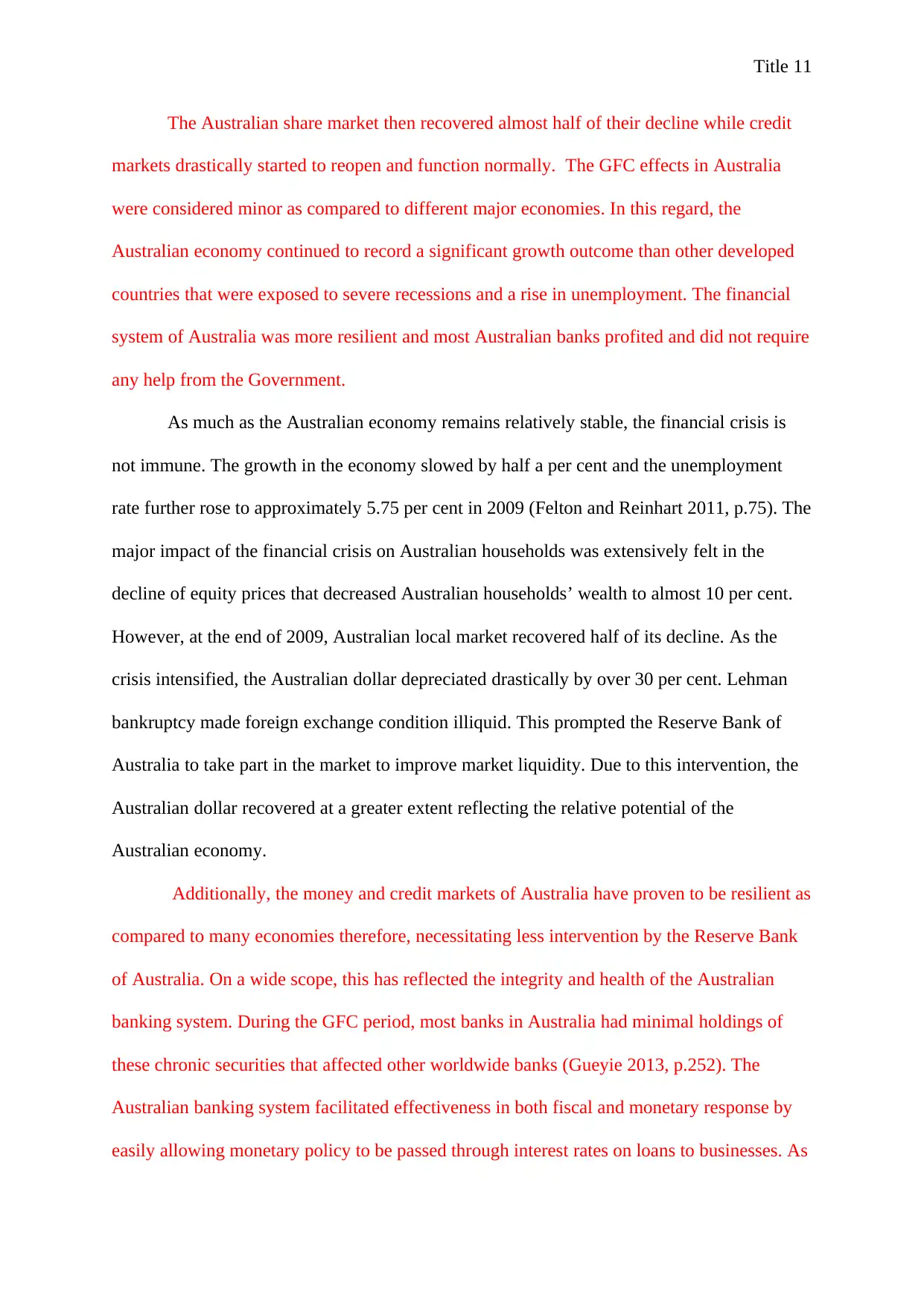
Title 11
The Australian share market then recovered almost half of their decline while credit
markets drastically started to reopen and function normally. The GFC effects in Australia
were considered minor as compared to different major economies. In this regard, the
Australian economy continued to record a significant growth outcome than other developed
countries that were exposed to severe recessions and a rise in unemployment. The financial
system of Australia was more resilient and most Australian banks profited and did not require
any help from the Government.
As much as the Australian economy remains relatively stable, the financial crisis is
not immune. The growth in the economy slowed by half a per cent and the unemployment
rate further rose to approximately 5.75 per cent in 2009 (Felton and Reinhart 2011, p.75). The
major impact of the financial crisis on Australian households was extensively felt in the
decline of equity prices that decreased Australian households’ wealth to almost 10 per cent.
However, at the end of 2009, Australian local market recovered half of its decline. As the
crisis intensified, the Australian dollar depreciated drastically by over 30 per cent. Lehman
bankruptcy made foreign exchange condition illiquid. This prompted the Reserve Bank of
Australia to take part in the market to improve market liquidity. Due to this intervention, the
Australian dollar recovered at a greater extent reflecting the relative potential of the
Australian economy.
Additionally, the money and credit markets of Australia have proven to be resilient as
compared to many economies therefore, necessitating less intervention by the Reserve Bank
of Australia. On a wide scope, this has reflected the integrity and health of the Australian
banking system. During the GFC period, most banks in Australia had minimal holdings of
these chronic securities that affected other worldwide banks (Gueyie 2013, p.252). The
Australian banking system facilitated effectiveness in both fiscal and monetary response by
easily allowing monetary policy to be passed through interest rates on loans to businesses. As
The Australian share market then recovered almost half of their decline while credit
markets drastically started to reopen and function normally. The GFC effects in Australia
were considered minor as compared to different major economies. In this regard, the
Australian economy continued to record a significant growth outcome than other developed
countries that were exposed to severe recessions and a rise in unemployment. The financial
system of Australia was more resilient and most Australian banks profited and did not require
any help from the Government.
As much as the Australian economy remains relatively stable, the financial crisis is
not immune. The growth in the economy slowed by half a per cent and the unemployment
rate further rose to approximately 5.75 per cent in 2009 (Felton and Reinhart 2011, p.75). The
major impact of the financial crisis on Australian households was extensively felt in the
decline of equity prices that decreased Australian households’ wealth to almost 10 per cent.
However, at the end of 2009, Australian local market recovered half of its decline. As the
crisis intensified, the Australian dollar depreciated drastically by over 30 per cent. Lehman
bankruptcy made foreign exchange condition illiquid. This prompted the Reserve Bank of
Australia to take part in the market to improve market liquidity. Due to this intervention, the
Australian dollar recovered at a greater extent reflecting the relative potential of the
Australian economy.
Additionally, the money and credit markets of Australia have proven to be resilient as
compared to many economies therefore, necessitating less intervention by the Reserve Bank
of Australia. On a wide scope, this has reflected the integrity and health of the Australian
banking system. During the GFC period, most banks in Australia had minimal holdings of
these chronic securities that affected other worldwide banks (Gueyie 2013, p.252). The
Australian banking system facilitated effectiveness in both fiscal and monetary response by
easily allowing monetary policy to be passed through interest rates on loans to businesses. As
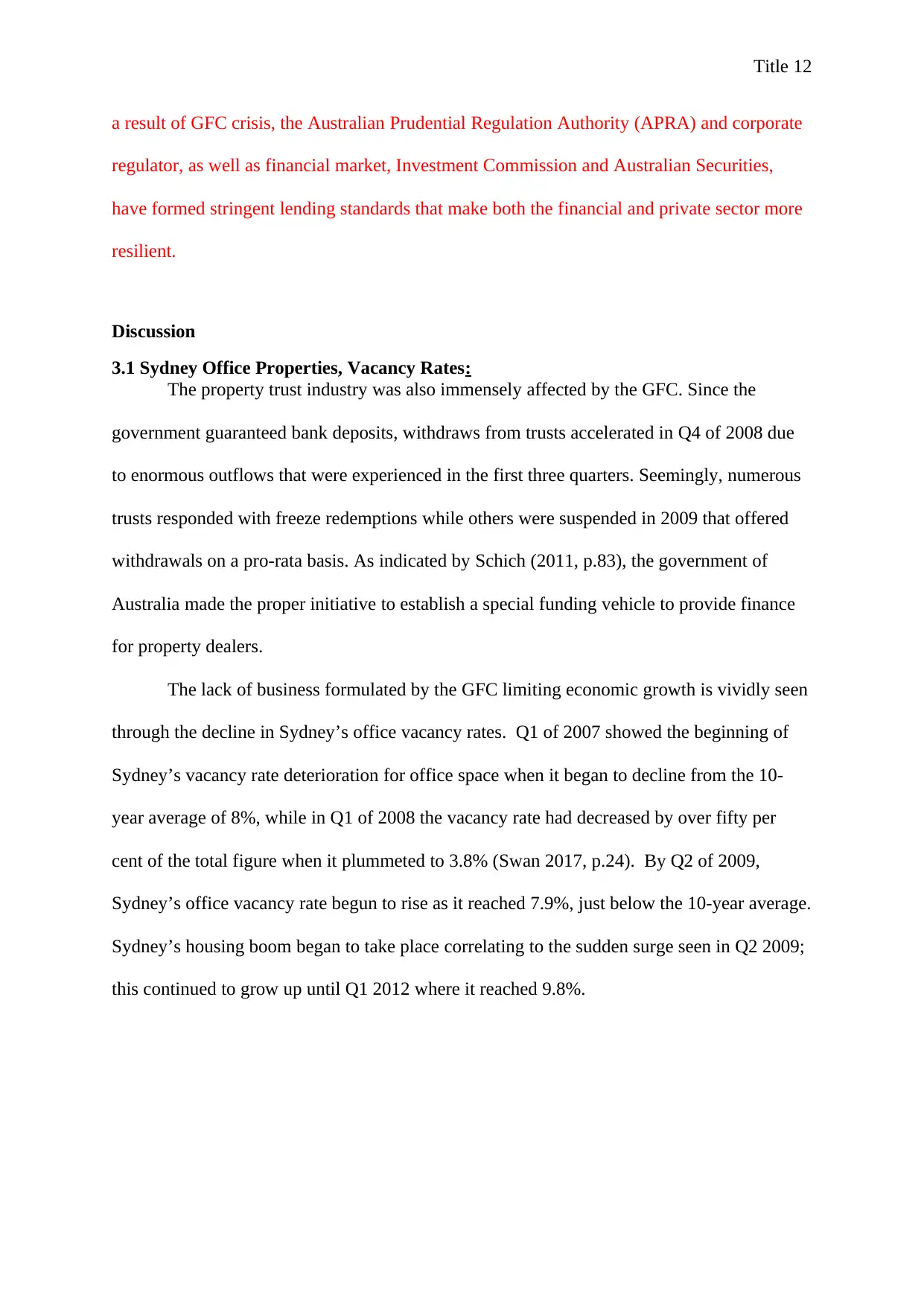
Title 12
a result of GFC crisis, the Australian Prudential Regulation Authority (APRA) and corporate
regulator, as well as financial market, Investment Commission and Australian Securities,
have formed stringent lending standards that make both the financial and private sector more
resilient.
Discussion
3.1 Sydney Office Properties, Vacancy Rates:
The property trust industry was also immensely affected by the GFC. Since the
government guaranteed bank deposits, withdraws from trusts accelerated in Q4 of 2008 due
to enormous outflows that were experienced in the first three quarters. Seemingly, numerous
trusts responded with freeze redemptions while others were suspended in 2009 that offered
withdrawals on a pro-rata basis. As indicated by Schich (2011, p.83), the government of
Australia made the proper initiative to establish a special funding vehicle to provide finance
for property dealers.
The lack of business formulated by the GFC limiting economic growth is vividly seen
through the decline in Sydney’s office vacancy rates. Q1 of 2007 showed the beginning of
Sydney’s vacancy rate deterioration for office space when it began to decline from the 10-
year average of 8%, while in Q1 of 2008 the vacancy rate had decreased by over fifty per
cent of the total figure when it plummeted to 3.8% (Swan 2017, p.24). By Q2 of 2009,
Sydney’s office vacancy rate begun to rise as it reached 7.9%, just below the 10-year average.
Sydney’s housing boom began to take place correlating to the sudden surge seen in Q2 2009;
this continued to grow up until Q1 2012 where it reached 9.8%.
a result of GFC crisis, the Australian Prudential Regulation Authority (APRA) and corporate
regulator, as well as financial market, Investment Commission and Australian Securities,
have formed stringent lending standards that make both the financial and private sector more
resilient.
Discussion
3.1 Sydney Office Properties, Vacancy Rates:
The property trust industry was also immensely affected by the GFC. Since the
government guaranteed bank deposits, withdraws from trusts accelerated in Q4 of 2008 due
to enormous outflows that were experienced in the first three quarters. Seemingly, numerous
trusts responded with freeze redemptions while others were suspended in 2009 that offered
withdrawals on a pro-rata basis. As indicated by Schich (2011, p.83), the government of
Australia made the proper initiative to establish a special funding vehicle to provide finance
for property dealers.
The lack of business formulated by the GFC limiting economic growth is vividly seen
through the decline in Sydney’s office vacancy rates. Q1 of 2007 showed the beginning of
Sydney’s vacancy rate deterioration for office space when it began to decline from the 10-
year average of 8%, while in Q1 of 2008 the vacancy rate had decreased by over fifty per
cent of the total figure when it plummeted to 3.8% (Swan 2017, p.24). By Q2 of 2009,
Sydney’s office vacancy rate begun to rise as it reached 7.9%, just below the 10-year average.
Sydney’s housing boom began to take place correlating to the sudden surge seen in Q2 2009;
this continued to grow up until Q1 2012 where it reached 9.8%.
⊘ This is a preview!⊘
Do you want full access?
Subscribe today to unlock all pages.

Trusted by 1+ million students worldwide
1 out of 28
Related Documents
Your All-in-One AI-Powered Toolkit for Academic Success.
+13062052269
info@desklib.com
Available 24*7 on WhatsApp / Email
![[object Object]](/_next/static/media/star-bottom.7253800d.svg)
Unlock your academic potential
Copyright © 2020–2025 A2Z Services. All Rights Reserved. Developed and managed by ZUCOL.




